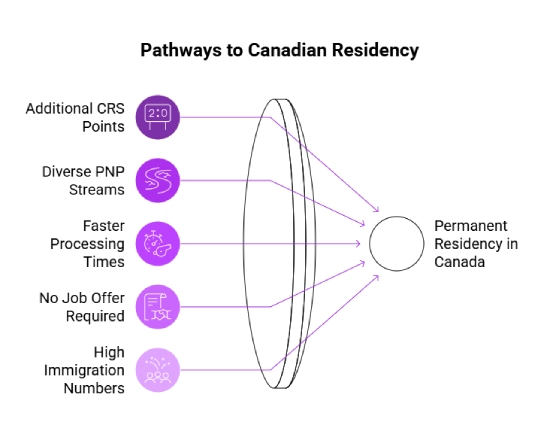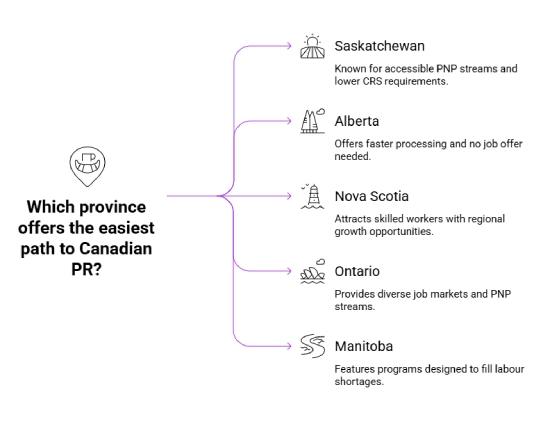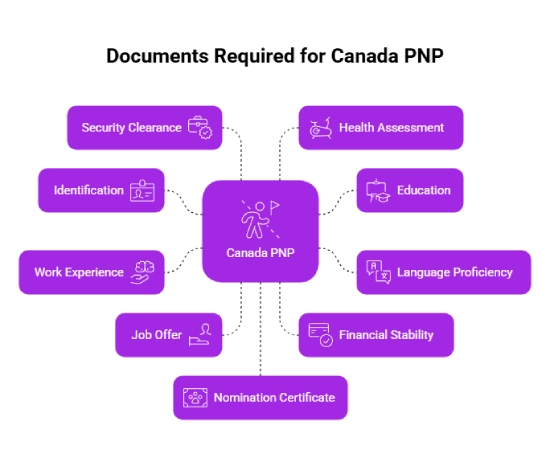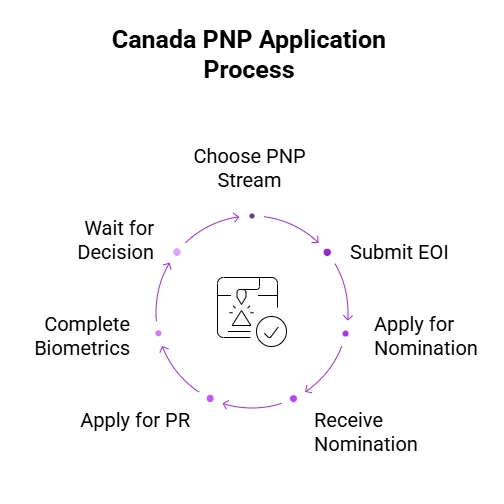Why Apply for the Canada PNP?
Canada's Provincial Nominee Program (PNP) offers a streamlined pathway for skilled professionals, entrepreneurs, and international graduates to obtain permanent residency. Each province creates its own PNP, which meets specific workforce demands to help applicants succeed in their PR applications.
- Receive 600 additional CRS points with a provincial nomination, almost guaranteeing an Invitation to Apply (ITA) for PR.
- Choose from over 80 PNP streams tailored to skilled workers, graduates, and entrepreneurs across Canada.
- Benefit from faster PR processing, with some PNPs issuing nominations in as little as 2–3 months.
- Apply without a job offer through several in-demand occupation and Express Entry-linked streams.
- Join over 105,000 immigrants welcomed annually through PNP programs across Canadian provinces.

What is the Canada PNP?
The Provincial Nominee Program (PNP) is a partnership between the federal government and provinces/territories, allowing provinces to nominate skilled workers, students, or business people who meet their local labour market needs. Nominees receive additional points in Express Entry or are invited to apply directly for permanent residency.
Benefits of the Canada PNP program
- Boosts Your PR Chances: A provincial nomination adds 600 points to your Express Entry score, giving you a significant advantage in receiving an Invitation to Apply (ITA) for permanent residency.
- Faster Immigration Process: Many PNP streams are linked to Express Entry and offer quicker processing times compared to federal programs.
- No Job Offer? No Problem: Several PNP streams allow skilled workers to apply without needing a Canadian job offer, depending on their occupation and profile.
- Diverse Pathways Available: With over 80 PNP streams across provinces, you can find options suited for skilled workers, international graduates, and entrepreneurs.
- Regional Settlement Opportunities: PNP helps you settle in regions that truly need your skills, increasing your chances of long-term success and community integration.
List of Canada PNP Programs by Province
Each province in Canada has its own immigration program designed to attract people who can help fill local job needs and support community growth.
Given below is the list of top Canada PNP programs:
- Alberta Advantage Immigration Program (AAIP)
- British Columbia Provincial Nominee Program (BC PNP)
- Manitoba Provincial Nominee Program (MPNP)
- New Brunswick Provincial Nominee Program (NBPNP)
- Newfoundland and Labrador Provincial Nominee Program (NLPNP)
- Northwest Territories Nominee Program (NTNP)
- Nova Scotia Nominee Program (NSNP)
- Ontario Immigrant Nominee Program (OINP)
- Prince Edward Island Provincial Nominee Program (PEI PNP)
- Saskatchewan Immigrant Nominee Program (SINP)
- Yukon Nominee Program (YNP)
*Want to apply for Canada PNP? Let Y-Axis assist you with the process.
Best Provinces for Easy Canada PR
Some provinces offer more accessible PNP streams with lower CRS score requirements, faster processing, or no job offer needed. These programs are designed to attract skilled workers who can contribute to regional growth and fill labour shortages. If you're aiming for a smoother path to Canadian PR, these provinces are great starting points.
Top Provinces for Easier PR:
- Saskatchewan
- Alberta
- Nova Scotia
- Ontario
- Manitoba

How Does PNP Work with Express Entry?
Provinces can nominate applicants through Express Entry–aligned streams.
Step 1: Create your Express Entry profile.
Step 2: A province issues a nomination, adding 600 CRS points.
Step 3: You receive an Invitation to Apply (ITA) in a PNP-specific draw.
Step 4: Submit your PR application to IRCC.
Note: This pathway significantly improves your chances of selection.
Eligibility Criteria for Canada PNP
The eligibility criteria for Canada PNP varies based on the province, however, here is a general criteria that needs to be fulfilled by Canada PNP applicants:
- Age: Most streams prefer candidates between 18 and 49 years old, though some accept older applicants based on skill and experience.
- Education: A minimum of a high school diploma is generally required, but post-secondary or professional qualifications may be necessary for skilled roles.
- Work Experience: You must have relevant, verifiable work experience in an occupation that’s in demand in the province you're applying to.
- Language Proficiency: Proof of English or French skills is mandatory, typically with a minimum CLB score of 5, but this can vary by stream.
- Intent to Reside: You must clearly demonstrate your intention to live and work in the province nominating you.
- Financial Stability: You’ll need to show proof of settlement funds to support yourself and your family after arrival, especially if you don’t have a job offer.
Documents Required for Canada PNP
The documents required for the Canada PNP are as follows:
- Valid passport
- Educational Credential Assessment (ECA)
- Language test results (IELTS, CELPIP, or TEF)
- Proof of work experience
- Job offer letter (if applicable)
- Proof of funds
- Police clearance certificate
- Medical examination results
- Provincial nomination certificate

How to Apply for the Canada PNP?
You can follow the steps below to apply for the Canada PNP:
Step 1: Choose a Provincial Nominee Program (PNP) stream that matches your skills, experience, and goals.
Step 2: Submit an Expression of Interest (EOI), if required by the province.
Step 3: Apply to the province or territory directly for a nomination under the selected PNP stream.
Step 4: If approved, receive a provincial nomination certificate.
Step 5: Apply for permanent residency through IRCC using your nomination.
Step 6: Complete biometrics and any required medical examinations.
Step 7: Wait for a decision on your PR application from IRCC.

CRS Score Impact of Nomination
A PNP nomination adds 600 points to your Comprehensive Ranking System (CRS) score, practically guaranteeing an ITA regardless of your base score. For example, candidates with base CRS in the 300s become highly eligible with a nomination.
Canada PNP vs Express Entry – What’s the Difference?
The table below has a complete overview of the major differences between Canada PNP and Express Entry:
|
Factor |
Provincial Nominee Program (PNP) |
Express Entry |
|
Pathway Type |
Provincial nomination program |
Federal immigration system |
|
Managed By |
Individual provinces and territories |
IRCC (Immigration, Refugees and Citizenship Canada) |
|
CRS Points Boost |
Adds 600 CRS points if aligned with Express Entry |
No additional boost unless nominated by a province |
|
Job Offer Requirement |
Not always required (depends on stream) |
Optional, but increases CRS score |
|
Application Process |
Two-step: Apply to province and then to IRCC |
Single-step: Apply directly through federal system |
|
Eligibility Criteria |
Varies by province and stream |
Standard federal eligibility requirements |
|
Processing Time |
2–8 months for nomination + 6–19 months for PR (average) |
6–8 months for complete PR processing |
|
Occupation Targeting |
Based on regional labour shortages |
Based on national occupation demand |
|
Settlement Obligation |
Must intend to live in the nominating province |
Can live and work anywhere in Canada |
|
Number of Streams |
80+ across all provinces |
3 main programs: FSWP, FSTP, and CEC |
Can you apply for PNP without a Job offer?
Yes, several provinces in Canada offer PNP streams that do not require a job offer. These programs focus on attracting skilled workers who meet local labour needs through education, work experience, and language proficiency.
You can apply to the following provinces even without a job offer:
- Ontario Human Capital Priorities Stream
- Saskatchewan Express Entry Sub-Category
- Saskatchewan Occupation in-Demand Sub-Category
- Nova Scotia Labour Market Priorities Stream
- Alberta Express Entry Stream
- Manitoba Skilled Worker Overseas Stream
- New Brunswick Express Entry Stream
- Prince Edward Island Express Entry Stream
Canada PNP Fees
The table below has a complete overview of the average processing fee for each of the Canada PNP programs:
|
PNP program |
Processing Fees (in CAD) |
|
Alberta Advantage Immigration Program (AAIP) |
$500 - $3,500 |
|
British Columbia Provincial Nominee Program (BCPNP) |
$1,150 - $3,500 |
|
Manitoba Provincial Nominee Program (MPNP) |
$500 - $2,500 |
|
New Brunswick Provincial Nominee Program (NB PNP) |
$250 - $2,000 |
|
Newfoundland and Labrador Provincial Nominee Program (NL PNP) |
$250 - $1,000 |
|
Nova Scotia Nominee Program (NSNP) |
NA |
|
Ontario Immigrant Nominee Program (OINP) |
$1,500 - $3,500 |
|
Prince Edward Island Provincial Nominee Program (PEI PNP) |
$300 - $10,000 |
|
Saskatchewan Immigrant Nominee Program (SINP) |
$350 - $2,500 |
|
Northwest Territories Nominee Program (NT PNP) |
$550 |
|
Yukon Provincial Nominee Program (YPNP) |
$1,325 |
Canada PNP Processing Time
The table below has a complete overview of the average processing time for each of the Canada PNP programs:
|
Province |
Average processing Time |
|
Alberta Advantage Immigration Program (AAIP) |
3-4 months |
|
British Columbia Provincial Nominee Program (BCPNP) |
3-4 months |
|
Manitoba Provincial Nominee Program (MPNP) |
4-5 months |
|
New Brunswick Provincial Nominee Program (NB PNP) |
6-8 weeks |
|
Newfoundland and Labrador Provincial Nominee Program (NL PNP) |
6-8 months |
|
Nova Scotia Nominee Program (NSNP) |
8-10 months |
|
Ontario Immigrant Nominee Program (OINP) |
3-4 months |
|
Prince Edward Island Provincial Nominee Program (PEI PNP) |
6-8 months |
|
Saskatchewan Immigrant Nominee Program (SINP) |
5-6 months |
|
Northwest Territories Nominee Program (NT PNP) |
16-18 months |
|
Yukon Provincial Nominee Program (YPNP) |
8-10 weeks |
Latest Canada PNP Draws
| Month | Provinces | No. of Draws | Total No. of Invitations |
|---|---|---|---|
| December | Ontario | 6 | 2,049 |
| British Columbia | 2 | 432 | |
| New Brunswick | 2 | 110 | |
| PEI | 1 | 166 | |
| Manitoba | 2 | 247 | |
| November | Newfoundland and Labrador | 1 | 330 |
| Alberta | 2 | 1125 | |
| British Columbia | 1 | 24 | |
| PEI | 1 | 190 | |
| Manitoba | 2 | 82 | |
| October | PEI | 1 | 160 |
| Newfoundland and Labrador | 2 | 225 | |
| Ontario | 3 | 1680 | |
| Manitoba | 2 | 891 | |
| Alberta | 12 | 2635 | |
| New Brunswick | 2 | 522 | |
| British Columbia | 1 | 485 | |
| September | Manitoba | 2 | 4258 |
| Alberta | 10 | 2819 | |
| PEI | 1 | 129 | |
| Newfoundland and Labrador | 2 | 570 | |
| Ontario | 5 | 4536 | |
| August | Manitoba | 2 | 114 |
| Alberta | 4 | 693 | |
| British Columbia | 1 | 16 | |
| Ontario | 3 | 468 | |
| PEI | 1 | 132 | |
| New Brunswick | 4 | 1052 | |
| Newfoundland and Labrador | 2 | 433 | |
| July | Manitoba | 1 | 67 |
| Alberta | 8 | 433 | |
| Newfoundland and Labrador | 2 | 509 | |
| British Columbia | 1 | 17 | |
| June | Alberta | 8 | 291 |
| PEI | 1 | 52 | |
| Manitoba | 2 | 528 | |
| New Brunswick | 4 | 608 | |
| Ontario | 6 | 3791 | |
| May | Newfoundland and Labrador | 2 | 733 |
| Alberta | 6 | 414 | |
| British Columbia | 2 | 108 | |
| PEI | 1 | 168 | |
| Manitoba | 3 | 118 | |
| April | Newfoundland and Labrador | 1 | 256 |
| Alberta | 7 | 246 | |
| New Brunswick | 2 | 477 | |
| British Columbia | 1 | 5 | |
| PEI | 1 | 168 | |
| Manitoba | 2 | 31 | |
| March | Alberta | 2 | 17 |
| PEI | 1 | 124 | |
| British Columbia | 1 | 13 | |
| New Brunswick | 1 | 498 | |
| Manitoba | 2 | 219 | |
| February | Alberta | 10 | 551 |
| PEI | 1 | 87 | |
| Manitoba | 2 | 117 | |
| Ontario | 1 | 4 | |
| January | Ontario | 1 | 4 |
| British Columbia | 1 | 10 | |
| PEI | 1 | 22 | |
| Manitoba | 2 | 325 |
How can Y-Axis help you?
Y-Axis is the world's No.1 overseas Immigration consultant, providing unbiased and innovative immigration assistance for 25+ years. Our team of experts will assist you with:
- Check free eligibility through the Y-Axis Canada Immigration Points Calculator
- Filling out the application form
- Assistance to migrate to Canada
- Arranging the requirements
- Looking for jobs in Canada? Avail Y-Axis Job Search Services to find the right one!
- Guidance to obtain Canada PR
Looking for Inspiration
Explore what Global Citizens have to say about Y-Axis in shaping their future
Frequently Asked Questions
